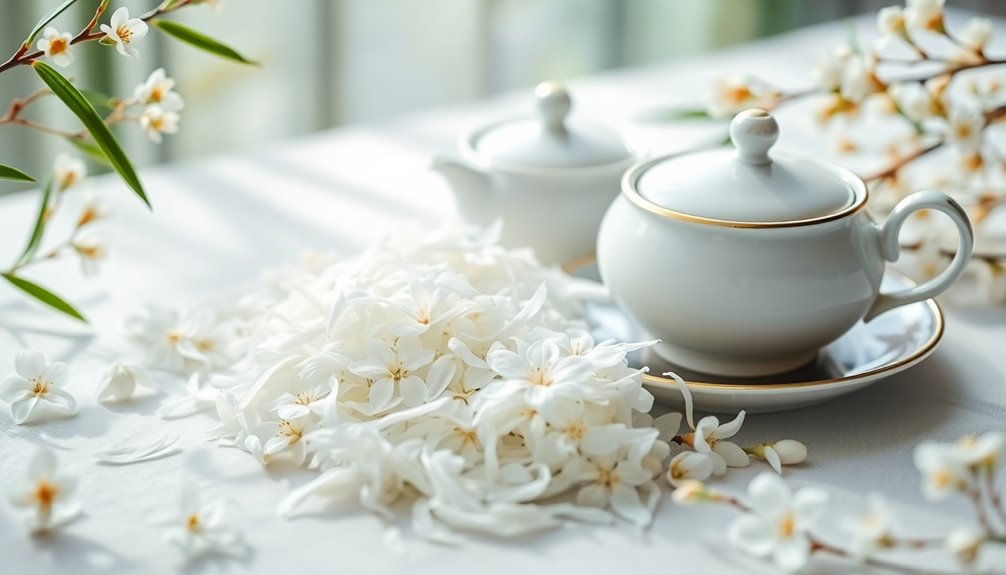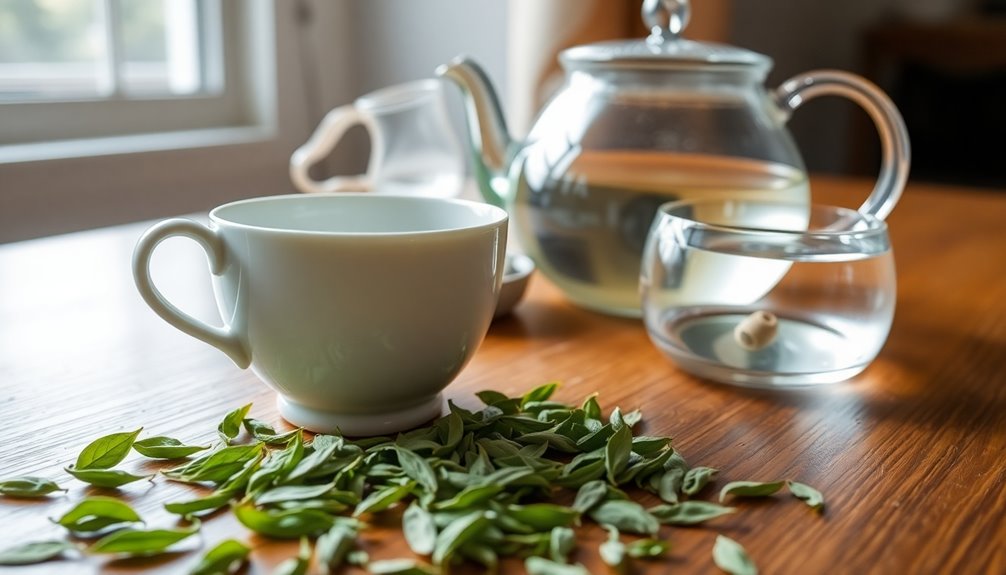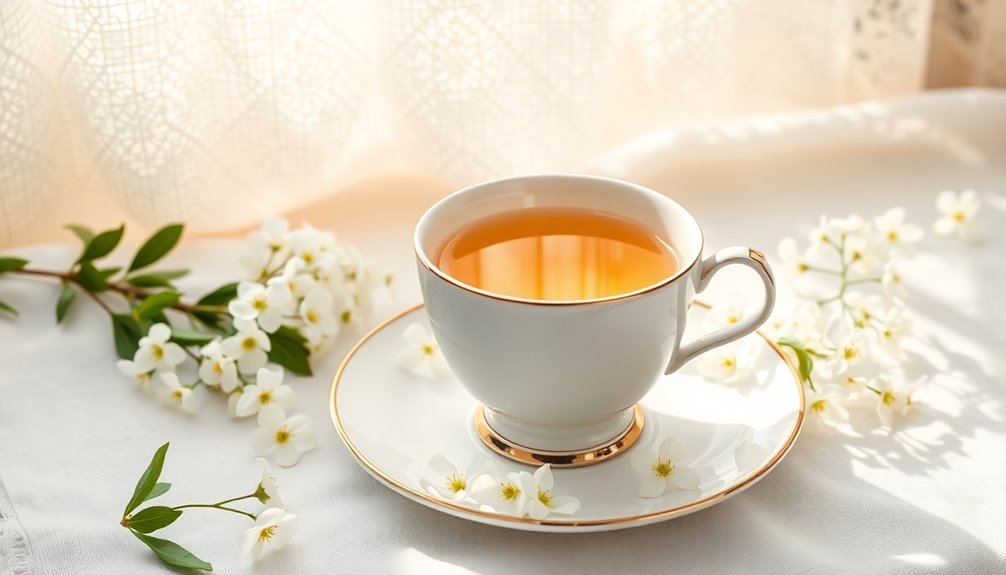Exploring white tea is exciting, especially with varieties like Bai Mu Dan and Silver Needle. Silver Needle comes from young buds, offering a light, floral taste, while Bai Mu Dan blends buds and leaves for a richer flavor with honeyed notes. For the best experience, brew Silver Needle at 170°F to 185°F for about 30 seconds, and Bai Mu Dan at 160°F to 180°F for around 3 minutes. Each tea has unique aromas and qualities, making them fun to taste. Learning about the brewing methods and flavor profiles will help you appreciate white tea even more!
Key Takeaways
- White tea includes varieties like Silver Needle and Bai Mu Dan, each with unique flavor profiles and characteristics.
- Silver Needle is made from young buds, offering a delicate, floral, and fruity flavor, often considered the highest quality.
- Bai Mu Dan combines buds and leaves, providing a fuller taste with honeyed and nutty notes, appealing to a broader audience.
- Brewing Silver Needle at 170°F to 185°F for 30 seconds to 1 minute enhances its sweetness and floral notes.
- Quality indicators include visual features, with Silver Needle showcasing downy buds and Bai Mu Dan displaying vibrant leaves.
Introduction
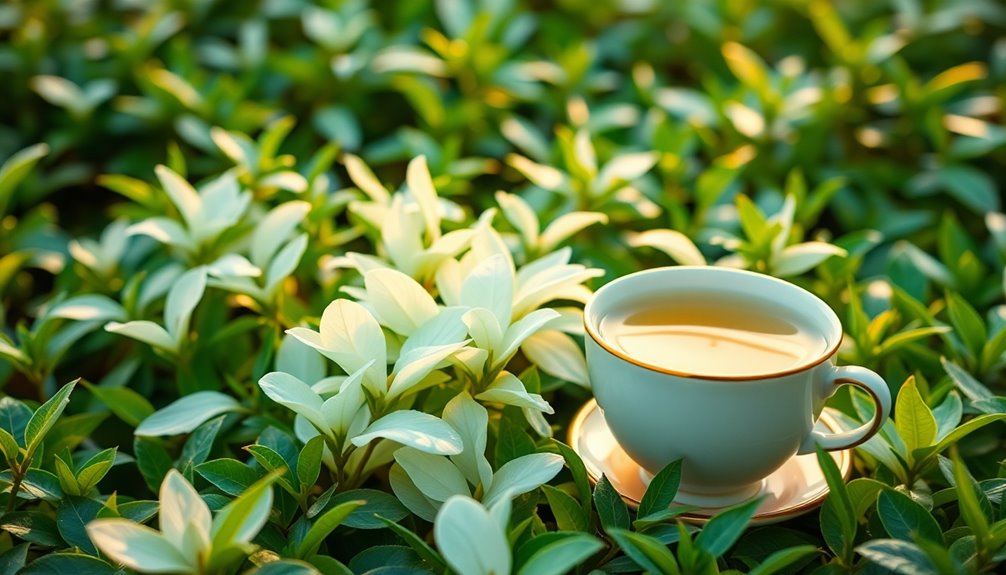
When it comes to tea, white tea stands out as one of the least processed varieties, offering a unique flavor experience that many appreciate. This delightful tea primarily consists of young buds and leaves, which create a delicate flavor profile filled with floral notes, nectar, and hints of stone fruit.
Among the most popular types of white tea are Silver Needle and Bai Mu Dan. Silver Needle is made exclusively from young, downy buds, making it the highest quality and often more expensive due to its limited production. On the other hand, Bai Mu Dan, or White Peony, includes buds and the first two leaves, providing a richer flavor while being more affordable.
White tea is also known for its high antioxidant content, which contributes to various health benefits, such as improved immunity and heart health. Additionally, regular consumption of herbal teas may enhance overall well-being and comfort.
The flavor and processing of white tea can vary based on its region of origin. Fujian Province is the traditional center for white tea production, but you might discover unique and flavorful varieties from places like Yunnan and Nepal.
White Tea's Historical Significance
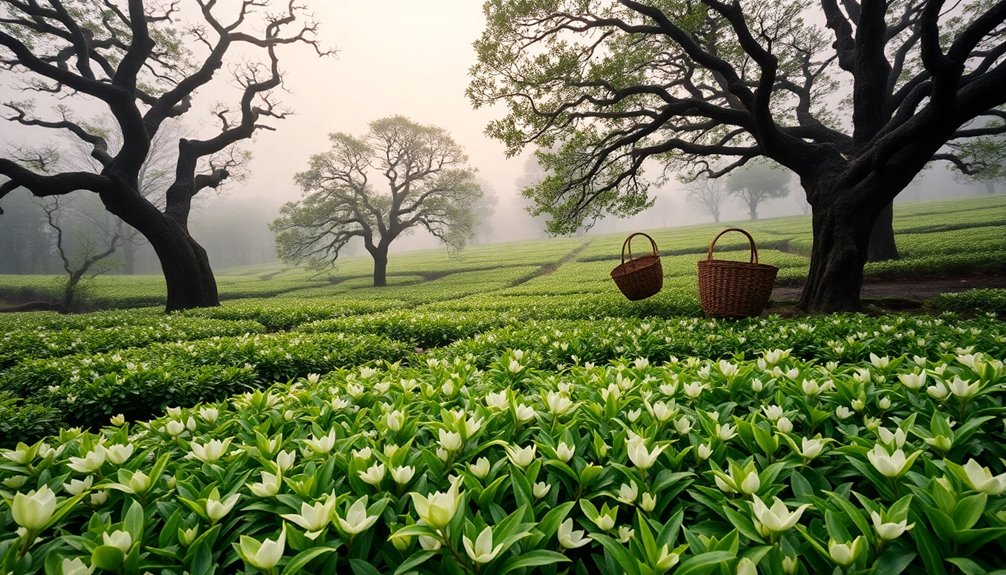
White tea boasts a rich historical significance that dates back over a millennium, deeply intertwined with Chinese culture. Its origins trace back to the Song Dynasty (920-1269), with earlier mentions in the Tang Dynasty (618-907), showcasing its long-standing importance.
At first, this special tea was a luxury for royalty, often presented as tribute to emperors by young virgins dressed in white gloves. This practice highlighted the exclusivity of good quality white tea.
Emperor Hui Zong was particularly obsessed with white tea, pouring resources into its production, which eventually contributed to his empire's decline.
During the Ming Dynasty (1368-1644), loose leaf white teas, like Silver Needle and Bai Mu Dan White, were introduced as tribute, changing how people prepared and enjoyed this delightful drink.
Today, white tea is loved not only for its history but also for its minimal processing and high antioxidant content. The leaves and buds used in making this tea offer a lovely floral aroma, making it a favorite around the world.
As you explore white tea, you'll appreciate its rich past and the tradition behind each sip.
Flavor Profiles Vary Significantly
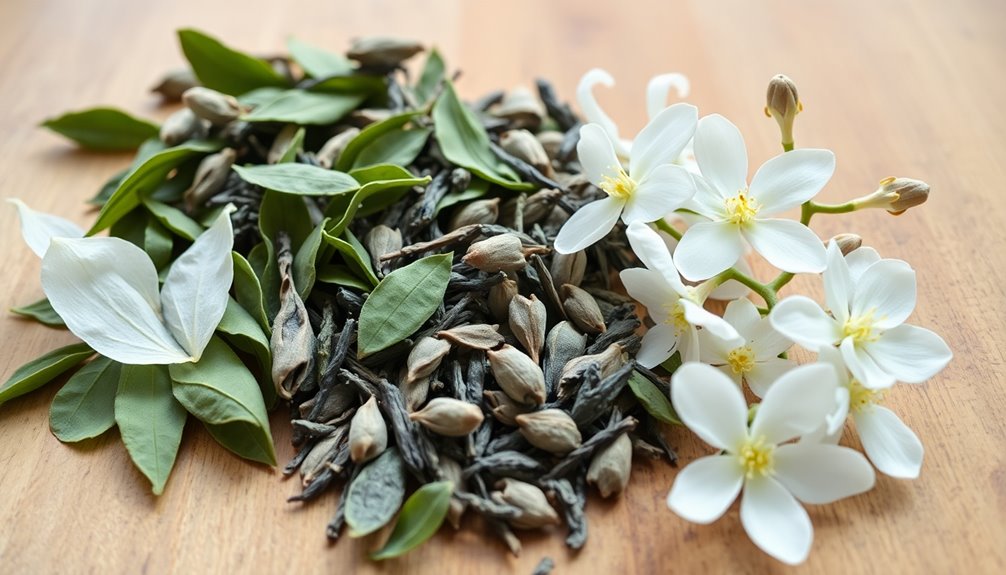
Exploring the world of white tea reveals that its flavor profiles vary significantly, each offering a unique experience.
Take Silver Needle, for example. This delicate tea is made from young white buds, giving it a light and airy flavor profile. You'll notice floral, fruity, and herbaceous notes, accompanied by a soft, creamy mouthfeel and a lingering sweetness that makes each sip delightful.
On the other hand, Bai Mu Dan, also known as White Peony, presents a richer flavor experience. It includes both buds and the first two leaves, which creates a fuller taste profile. With sweet honeyed undertones and nutty characteristics, it's more robust than Silver Needle. You'll enjoy its rich golden hue in your cup, reflecting its complex flavors.
Both teas bring unique aromas to your experience: Silver Needle often has light melon scents, while Bai Mu Dan features sweet, peachy, and floral notes.
Whether you prefer the lightness of Silver Needle or the richness of Bai Mu Dan, you're sure to find a white tea that suits your taste and elevates your tea-drinking adventure.
Brewing Temperatures Affect Flavor
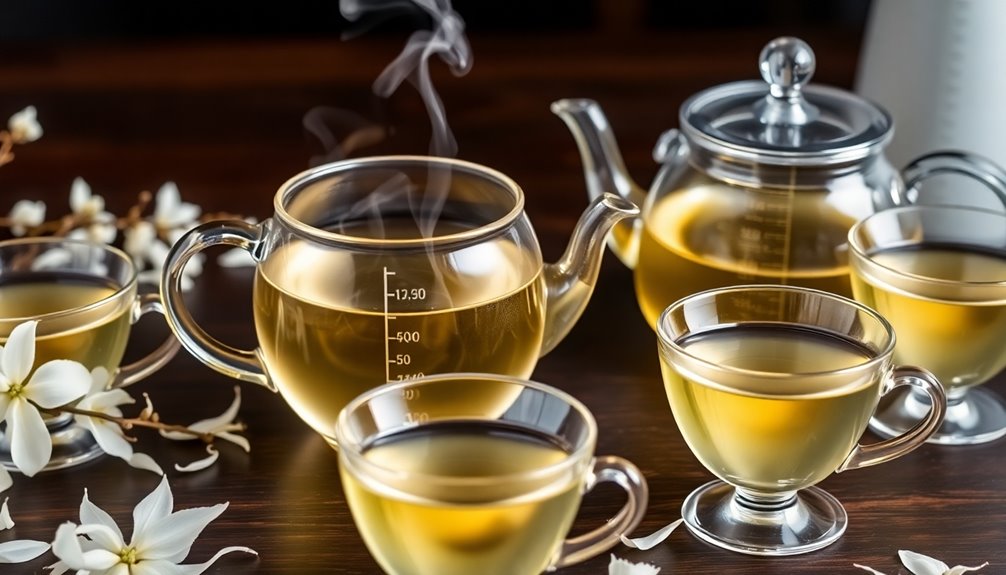
Brewing white tea at the right temperature is crucial for unlocking its full flavor potential. For Silver Needle, a sought-after variety, you should aim for a brewing temperature between 170°F and 185°F (77°C to 85°C). This range helps preserve its delicate flavor profile without introducing bitterness.
On the other hand, for Bai Mu Dan, you'll want to keep the temperature slightly lower, around 160°F to 180°F (71°C to 82°C). This enhances the sweet and herbaceous notes of the tea buds.
If you brew these teas at too high a temperature, you might end up with astringency and muddied flavors, which can dull the natural sweetness and floral characteristics.
Steeping time is also important. Silver Needle should steep for about 30 seconds to 1 minute, while Bai Mu Dan typically requires around 3 minutes to extract optimal flavors.
Cultural Perceptions of Quality
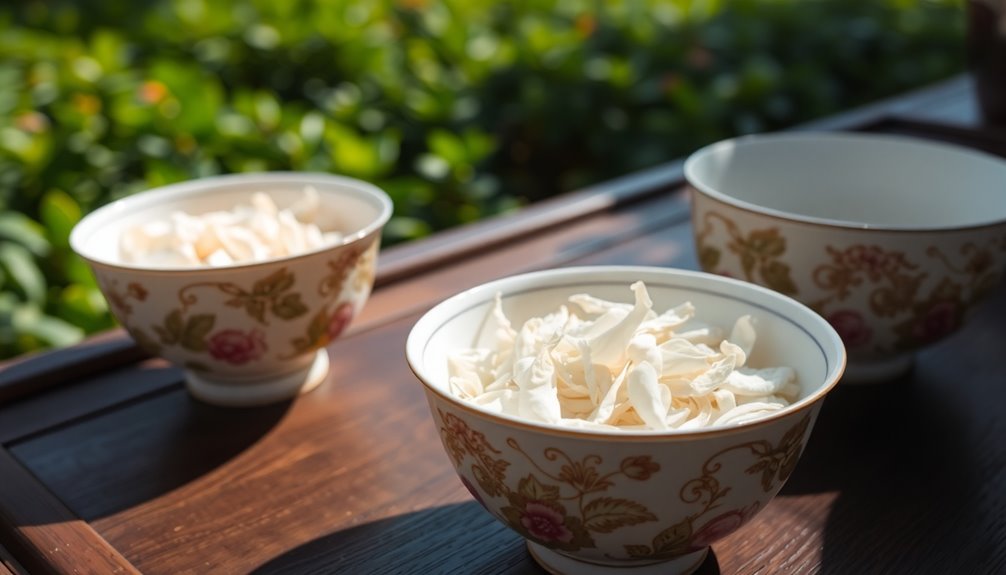
Understanding how brewing temperatures affect flavor is just one part of appreciating white tea. When it comes to cultural perceptions of quality, Silver Needle often sits at the top. This tea type uses only young buds, which are downy white and symbolize freshness. Its minimal processing and delicate flavor make it highly sought after, but it can be pricey.
On the other hand, Bai Mu Dan, or White Peony, offers a great balance of flavor and price. It includes both buds and young leaves of the tea, making it appealing to everyone, from beginners to seasoned drinkers.
Quality indicators in white tea are usually based on visual features. Silver Needle's thick, downy buds signify its high grade, while Bai Mu Dan is known for its vibrant leaves and a good mix of buds.
Different regions also play a role in how quality is perceived. For instance, Fujian Silver Needle is loved for its refined taste, while Yunnan Silver Needle is known for its bolder flavors.
Understanding these aspects can enhance your appreciation of these white tea types, helping you choose the best one for your taste buds!
Practical Applications
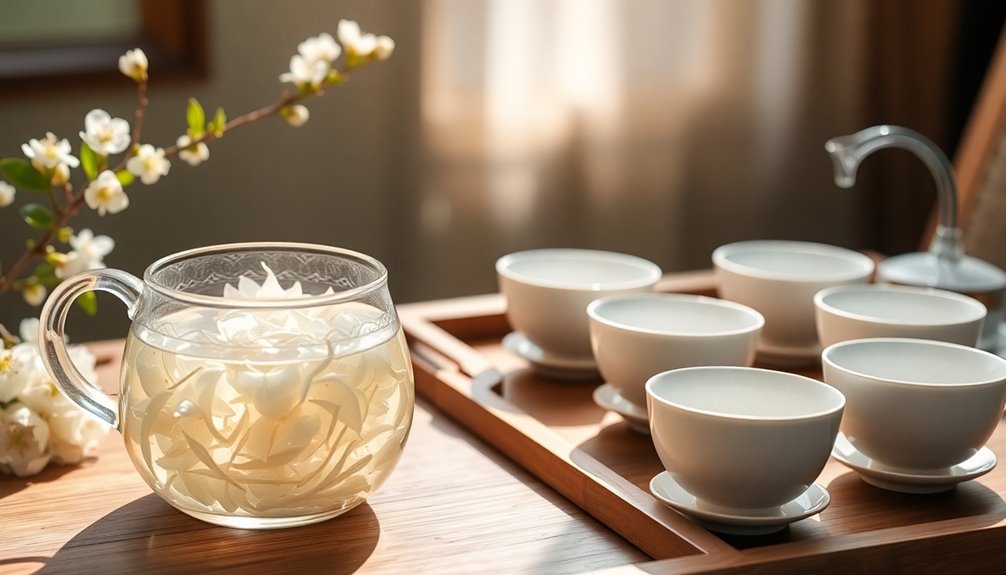
When it comes to enjoying white tea, knowing the right brewing techniques can elevate your experience.
Start with Silver Needle, which is made from delicate young buds. For the best flavor, heat your water to at least 90°C (195°F) and steep the tea leaves for about 30 seconds to 1 minute. This will give you a gentle, sweet taste.
Bai Mu Dan, on the other hand, includes both buds and the first two leaves, resulting in a richer flavor. Brew it at slightly lower temperatures, between 170°F and 185°F, for about 3 minutes.
If you prefer cold brewing, Silver Needle works wonderfully! Use 15-30 grams of leaves per liter of water and let it steep in the fridge for 8-12 hours. This method highlights its natural sweetness.
To keep your white teas fresh, store them in airtight containers in a cool, dark place. Aim to use them within a year for the best flavor profiles.
Frequently Asked Questions
What Is the Difference Between Bai Mu Dan and Silver Needle?
Bai Mu Dan and Silver Needle differ in composition—Bai Mu Dan includes leaves and buds, while Silver Needle uses only buds. Their flavors also vary, with Silver Needle being lighter and Bai Mu Dan richer and nuttier.
What Is White Silver Needle Tea Good For?
Silver Needle tea's packed with antioxidants, boosts your immune system, and promotes skin health. Its caffeine and theanine enhance your focus, while polyphenols support metabolism, heart health, and overall wellness. You won't regret trying it!
What Are the 4 Grades of White Tea?
The four grades of white tea are Silver Needle, White Peony, Gong Mei, and Shou Mei. Each grade varies in flavor and quality, with Silver Needle being the highest and Shou Mei the lowest.
What Are the Different Types of White Tea?
You'll find five main types of white tea: Silver Needle, White Peony, Gong Mei, Shou Mei, and Fujian New Craft. Each has unique characteristics, flavors, and aromas that cater to different preferences and tastes.
Conclusion
Now that you've explored the different types of white tea, like Bai Mu Dan and Silver Needle, you can appreciate their unique flavors and aromas. Remember, brewing at the right temperature can make a big difference in taste. Each variety has its own story and cultural background, adding to its charm. So, grab your favorite white tea, brew it properly, and enjoy a soothing cup while discovering even more about this delightful drink!

